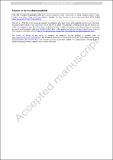| dc.contributor.author | Ni, Bo | |
| dc.contributor.author | Steinbach, Doug | |
| dc.contributor.author | Yang, Zhenze | |
| dc.contributor.author | Lew, Andrew | |
| dc.contributor.author | Zhang, Boyu | |
| dc.contributor.author | Fang, Qiyi | |
| dc.contributor.author | Buehler, Markus J. | |
| dc.contributor.author | Lou, Jun | |
| dc.date.accessioned | 2022-10-18T11:56:07Z | |
| dc.date.available | 2022-10-18T11:56:07Z | |
| dc.date.issued | 2022-09-21 | |
| dc.identifier.uri | https://hdl.handle.net/1721.1/145881 | |
| dc.description.abstract | Abstract
More than a century ago, A.A. Griffith published the seminal paper establishing the foundational framework for fracture mechanics. The elegant theory creatively introduced the concepts of elastic energy and surface energy to the science of fracture, and solved the problem of brittle fracture of glass materials. Many subsequent milestone studies in fracture mechanics were motivated by the real problems encountered in different materials. The emergence of two-dimensional (2D) materials provides an exciting opportunity to examine fracture processes at the 2D limit. An important question to be addressed is whether the classic Griffith theory is still applicable to 2D materials. Therefore, recent progress in both experimental and theoretical studies of fracture of 2D materials will be briefly reviewed, with new developments and discoveries in relevant techniques and theories highlighted. Given the early stage of exploring fracture behaviors in 2D materials, more emphasis will be placed on challenges and opportunities for this budding field.
Graphical abstract | en_US |
| dc.publisher | Springer International Publishing | en_US |
| dc.relation.isversionof | https://doi.org/10.1557/s43577-022-00385-4 | en_US |
| dc.rights | Creative Commons Attribution-Noncommercial-Share Alike | en_US |
| dc.rights.uri | http://creativecommons.org/licenses/by-nc-sa/4.0/ | en_US |
| dc.source | Springer International Publishing | en_US |
| dc.title | Fracture at the two-dimensional limit | en_US |
| dc.type | Article | en_US |
| dc.identifier.citation | Ni, Bo, Steinbach, Doug, Yang, Zhenze, Lew, Andrew, Zhang, Boyu et al. 2022. "Fracture at the two-dimensional limit." | |
| dc.contributor.department | Massachusetts Institute of Technology. Department of Civil and Environmental Engineering | |
| dc.eprint.version | Author's final manuscript | en_US |
| dc.type.uri | http://purl.org/eprint/type/JournalArticle | en_US |
| eprint.status | http://purl.org/eprint/status/PeerReviewed | en_US |
| dc.date.updated | 2022-10-18T03:18:05Z | |
| dc.language.rfc3066 | en | |
| dc.rights.holder | The Author(s), under exclusive License to the Materials Research Society | |
| dspace.embargo.terms | Y | |
| dspace.date.submission | 2022-10-18T03:18:05Z | |
| mit.license | OPEN_ACCESS_POLICY | |
| mit.metadata.status | Authority Work and Publication Information Needed | en_US |
